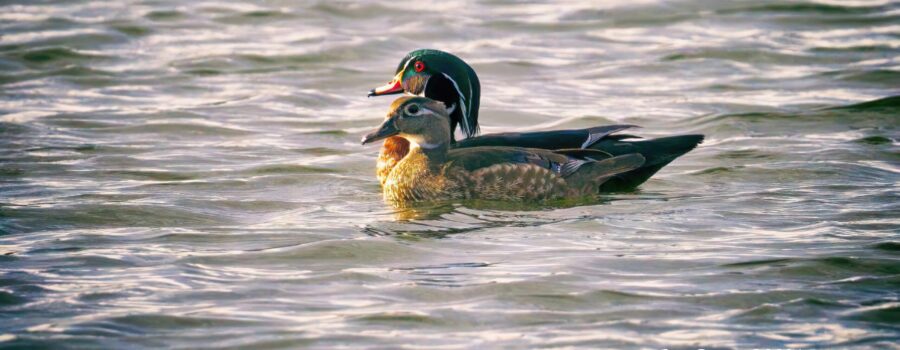I have quite a few nest boxes located in Oak trees along the lake and back into the pasture for the Wood ducks. I’ll be replacing a number of them this year – with the help of a friend – as they are beginning to show their age. Some are over 27 years old! I love playing host to these gorgeous waterfowl. Interestingly, their nearest relative is the Mandarin duck found in eastern Asia. I’ll include a photo of the Mandarin duck for comparison. It, too, is a little dazzler!


The Mandarin duck is quite embellished but we certainly can see common features between the Wood duck and the Mandarin duck. Pretty cool ducks!
Getting back to the Wood duck nest boxes
Nest boxes are generally 12″x12″x22″ with a 3″x 4″ oval hole approximately 18″ from the base. It is amazing to watch the hens coursing through the woods and flying into the nest boxes. They come at them at full speed. They have to. Owls and Raptors are waiting for the hen’s daily arrivals and departures to/from the nest box. A dangerous game they play. I have watched hens get swooped by a Great Horned Owl – missing by inches – as the hen dives for the safety of the nest box.

The entrance of the nest box has to be kept to a minimum to prevent Raccoons from raiding the nests. That is also why nest boxes have the depth they do, so a Raccoon cannot reach into the box and grab an egg. One constant problem with providing nest boxes for Wood ducks is Squirrels. These opportunistic rodents find the nest boxes to be ideal homes. Every Spring, with the arrival of the Wood ducks, there are squabbles with Squirrels. Amazingly, the Wood ducks generally win out and lay claim to the nest box.
It’s all about survival of the egg clutch for the Wood ducks
Here’s a shot of a hen departing the nest box post haste. You need to search a bit for the hen. I was waiting for this hen to leave the box, holding camera up at the ready. From the moment I spotted her leaving the nest box to the moment I captured her image, she had already flown some distance.

It is interesting to observe the hen’s arrival to the nest box as the drake follows with her. He is a decoy of sorts and creates a distraction so the hen has a better chance of arriving safely to the nest box. It’s all about survival and bringing forth the next generation of Wood ducks.
Ducks in trees
The first time I saw a Wood duck in a tree I was amazed. I thought to myself, “That’s not right.” And to see a Wood duck navigate our thick stand of Oak is beyond amazing. They course through all the branches weaving and dodging – but they do it effortlessly. This is attributable to their long tail feathers which the Wood duck uses as a sort of rudder. Superb design feature!
Here are a couple shots of Wood ducks in trees:


My love for Wood ducks
I am especially fond of the Wood duck and want to do all I can to protect them and increase their numbers. Wood ducks were thought to be threatened with extinction in the early twentieth century. This was largely due to harvesting large trees for lumber that Wood ducks used for nesting. That, and unregulated hunting pressure. The Wood duck is a conservation success story today with habitat restoration – including the placement of nest boxes – along with reasonable hunting regulations.
Closing
A brief recap of Wood ducks. I like to call them “WoodWards” and I’m not sure why. What I do know is they are a beautiful bird. I love to photograph them while they are here. Wood ducks are some of the first to arrive and some of the first to depart. I hope you have enjoyed this summary! If you want to see more images of Wood ducks, you can do so at RedBarnProject.com. They have their own Gallery at the site. Please contact me here if you have any questions. Peace.


